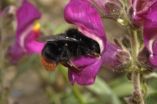(Press-News.org) A team of international researchers led by ancient DNA experts from the University of Adelaide has resolved the longstanding issue of the origins of the people who introduced farming to Europe some 8000 years ago.
A detailed genetic study of one of the first farming communities in Europe, from central Germany, reveals marked similarities with populations living in the Ancient Near East (modern-day Turkey, Iraq and other countries) rather than those from Europe.
Project leader Professor Alan Cooper, Director of the Australian Centre for Ancient DNA (ACAD) at the University of Adelaide, says: "This overturns current thinking, which accepts that the first European farming populations were constructed largely from existing populations of hunter-gatherers, who had either rapidly learned to farm or interbred with the invaders."
The results of the study have been published today in the online peer-reviewed science journal PLoS Biology.
"We have finally resolved the question of who the first farmers in Europe were – invaders with revolutionary new ideas, rather than populations of Stone Age hunter-gatherers who already existed in the area," says lead author Dr Wolfgang Haak, Senior Research Associate with ACAD at the University of Adelaide.
"We've been able to apply new, high-precision ancient DNA methods to create a detailed genetic picture of this ancient farming population, and reveal that it was radically different to the nomadic populations already present in Europe.
"We have also been able to use genetic signatures to identify a potential route from the Near East and Anatolia, where farming evolved around 11,000 years ago, via south-eastern Europe and the Carpathian Basin (today's Hungary) into Central Europe," Dr Haak says.
The project involved researchers from the University of Mainz and State Heritage Museum in Halle, Germany, the Russian Academy of Sciences and members of the National Geographic Society's Genographic Project, of which Professor Cooper is a Principal Investigator and Dr Haak is a Senior Research Associate.
The ancient DNA used in this study comes from a complete graveyard of Early Neolithic farmers unearthed at the town of Derenburg in Saxony-Anhalt, central Germany.
"This work was only possible due to the close collaboration of archaeologists excavating the skeletons, to ensure that no modern human DNA contaminated the remains, and nicely illustrates the potential when archaeology and genetics are combined," says Professor Kurt Werner Alt from the collaborating Institute of Anthropology in Mainz, Germany.
INFORMATION:
Media contacts:
Professor Alan Cooper
Director, Australian Centre for Ancient DNA
The University of Adelaide
Phone: +61 8 8303 5950
alan.cooper@adelaide.edu.au
Dr Wolfgang Haak
Genographic Project Senior Research Associate
Australian Centre for Ancient DNA
The University of Adelaide
Phone: +61 8 8303 5565
wolfgang.haak@adelaide.edu.au
DNA reveals origins of first European farmers
2010-11-10
ELSE PRESS RELEASES FROM THIS DATE:
Astronomers find star system that looks like game of snooker
2010-11-10
Astronomers at The University of Warwick and the University of Sheffield have helped discover an unusual star system which looks like, and may even once have behaved like, a game of snooker.
The University of Warwick and Sheffield astronomers played a key role in an international team that used two decades of observations from many telescopes around the world. The UK astronomers helped discover this "snooker like" star system through observations and analysis of data from an astronomical camera known as ULTRACAM designed by the British researchers on the team.
They ...
Softening crystals without heat: Using terahertz pulses to manipulate molecular networks
2010-11-10
Kyoto, Japan -- As if borrowing from a scene in a science fiction movie, researchers at Kyoto University have successfully developed a kind of tractor beam that can be used to manipulate the network of the molecules. In a paper soon to be published in Physical Review Letters, the team has demonstrated a technique using terahertz pulses that could have broad applications in the chemical and pharmaceutical industries.
Terahertz waves, an area of specialty for the Koichiro Tanaka lab at Kyoto University's Institute for Integrated Cell-Material Sciences (iCeMS), exist in ...
Recommendation letters may be costing women jobs, promotions
2010-11-10
A recommendation letter could be the chute in a woman's career ladder, according to ongoing research at Rice University. The comprehensive study shows that qualities mentioned in recommendation letters for women differ sharply from those for men, and those differences may be costing women jobs and promotions in academia and medicine.
Funded by the National Science Foundation, Rice University professors Michelle Hebl and Randi Martin and graduate student Juan Madera, now an assistant professor at the University of Houston, reviewed 624 letters of recommendation for 194 ...
Lab on chip for membrane proteins
2010-11-10
Membrane-associated receptors, channels and transporters are among the most important drug targets for the pharmaceutical industry. The search for new drugs resembles looking for a needle in a haystack. Therefore new analytical techniques are required which facilitate the simultaneous screening of a large library of compounds across a variety of membrane proteins. However, this class of methods is still at the early stages of development. The group of Prof. Dr. Robert Tampé, in collaboration with the Walter Schottky Institute at Technical University Munich, has now presented ...
Quantum computers a step closer to reality thanks to new finding
2010-11-10
Quantum computers should be much easier to build than previously thought, because they can still work with a large number of faulty or even missing components, according to a study published today in Physical Review Letters. This surprising discovery brings scientists one step closer to designing and building real-life quantum computing systems – devices that could have enormous potential across a wide range of fields, from drug design, electronics, and even code-breaking.
Scientists have long been fascinated with building computers that work at a quantum level – so small ...
How the dragon got its 'snap'
2010-11-10
VIDEO:
This is a computer model of the growth of a snapdragon flower, produced by the groups of Professor Andrew Bangham of the University of East Anglia and Professor Enrico Coen...
Click here for more information.
"How do hearts, wings or flowers get their shape?" asks Professor Enrico Coen from the John Innes Centre. " Unlike man-made things like mobile phones or cars, there is no external hand or machine guiding the formation of these biological structures; they ...
MicroRNA controls mammary gland development in mice
2010-11-10
This release is available in German.
Hormones, growth factors and several proteins ensure that development occurs in the right way, at the right time. The components that cause breast development in mammals, for example, were thought to be largely known. However, as a team of scientists from Göttingen, Frankfurt and Hanover have now discovered, in the case of breast development, hormones and proteins do not account for the full story. The scientists have shown that tiny ribonucleic acid molecules play a key role in this process. The mammary glands of mice lacking the ...
Scientists identify 1 cause of damage in Alzheimer's disease and find a way to stop it
2010-11-10
Researchers suspect that a protein superstructure called amyloid beta is responsible for much of the neural damage of Alzheimer's disease.
A new study at the University of California, San Diego, shows that amyloid beta disrupts one of the brain's anti-oxidant proteins and demonstrates a way to protect that protein, and perhaps others, from amyloid's harmful effects.
"Amyloid seems to cause damage to cells," said chemistry professor Jerry Yang. "We have reported in a very detailed way one potential interaction of how amyloid can cause disease, and we found a way to ...
Parents should talk about math early and often with their children
2010-11-10
VIDEO:
University of Chicago psychologist Susan Levine has found that early exposure to mathematics words prepares students for success later in school.
Click here for more information.
The amount of time parents spend talking about numbers has a much bigger impact on how young children learn mathematics than was previously known, researchers at the University of Chicago have found.
For example, children whose parents talked more about numbers were much more likely to ...
Sunburnt whales
2010-11-10
Whales exhibit skin damage consistent with acute sunburn in humans, and it seems to be getting worse over time, reveals research published this week in Proceedings of the Royal Society B.
Scientists from the Zoological Society of London (ZSL), Queen Mary, University of London and CICIMAR, studied blue whales, fin whales and sperm whales in the Gulf of California to determine the effect of rising levels of ultraviolet radiation (UVR) on their health.
For a number of years scientists have observed blisters on the skin of whales. Now, using high-quality photos to give ...




